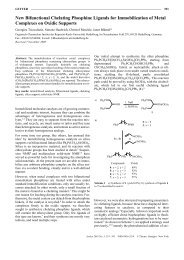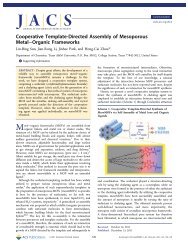Singlet Fission - Department of Chemistry
Singlet Fission - Department of Chemistry
Singlet Fission - Department of Chemistry
You also want an ePaper? Increase the reach of your titles
YUMPU automatically turns print PDFs into web optimized ePapers that Google loves.
AF Chemical Reviews, XXXX, Vol. xxx, No. xx Smith and Michl<br />
in transient absorption measurements performed under<br />
identical conditions on a single crystal <strong>of</strong> 3, and the authors<br />
attributed its absence to different morphology. 147,179 However,<br />
since they did not specify the monitoring laser beam<br />
polarization direction relative to crystal or molecular axes,<br />
one cannot exclude the possibility that A was formed but its<br />
transition moment was out <strong>of</strong> alignment with the electric field<br />
<strong>of</strong> the monitoring laser beam.<br />
The dynamics <strong>of</strong> the decay <strong>of</strong> A can be altered by the<br />
presence <strong>of</strong> underlying structures. For 3 on glass, 149 there is<br />
an initial fast (∼175 fs) component <strong>of</strong> absorption decay,<br />
which is not observed for 3 on Ag nanohole films. This is<br />
thought to be due to changes in the rate <strong>of</strong> vibrational cooling<br />
or in the relative energies <strong>of</strong> the S1 and T1 states due to<br />
interaction with surface plasmons.<br />
In ultrafast transient absorption studies <strong>of</strong> films <strong>of</strong> 3, 147,179,151<br />
the spectral signature <strong>of</strong> A is less clear. Upon cooling to 5<br />
K, 151 the spectra change considerably, and the peak <strong>of</strong> A<br />
becomes more prominent relative to ground-state bleach. It<br />
is not obvious whether the results represent an observation<br />
<strong>of</strong> an additional transient species (D) with a sharp peak at<br />
1.9 eV that also lives for many ns and whose formation is<br />
enhanced when the film is doped with C60.<br />
Species B. This transient has only been detected in a thin<br />
film <strong>of</strong> 3 observed at 65° incidence, as a weak absorption<br />
band at 2.30 eV. 76,77 Its rise time <strong>of</strong> ∼1 ps and a lifetime <strong>of</strong><br />
a few hundred ps are clearly distinct from those <strong>of</strong> A and<br />
demand the assignment <strong>of</strong> B as a different species. The 2.3<br />
eV band is not seen at normal incidence under otherwise<br />
identical conditions and is therefore evidently polarized along<br />
the long axis <strong>of</strong> 3.<br />
Species C. This transient, with a broad absorption peak<br />
at 1.4 eV, a temperature-independent 700 fs rise time, and a<br />
lifetime <strong>of</strong> many ns, was observed in a study 147,179 <strong>of</strong> a single<br />
crystal and in thin films <strong>of</strong> 3, 147,179,151 where its rise time is<br />
shorter than the 200 fs time resolution <strong>of</strong> the measurement. 151<br />
In a thin film, the intensity <strong>of</strong> this absorption peak relative<br />
to the ground-state bleach was much weaker than in the<br />
single crystal and was reduced further when the film was<br />
doped with C60. 147,179 The authors attribute the difference<br />
between results for a single crystal and a film to different<br />
morphology. Another possible explanation is that the 1.4 eV<br />
transition in C is mostly long-axis polarized and therefore<br />
hard to observe in their thin films at normal incidence (the<br />
ground-state absorption is short-axis polarized).<br />
Proposed Interpretations. Four different hypotheses have<br />
been presented to account for the fast decay <strong>of</strong> the initially<br />
excited S1 state to the species A observed in solid 3, and the<br />
authors <strong>of</strong>ten differ in the interpretation <strong>of</strong> the nature <strong>of</strong> the<br />
transients B and C as well. The proposed fates <strong>of</strong> S1 are (i)<br />
fission to free triplet excitons, which have been assigned by<br />
some authors 150 (and later accepted by certain others 149,207 )<br />
as species A, in other publications as species C, 147,179,151 and<br />
in one paper as species B 77 (which we consider the most<br />
likely), (ii) formation <strong>of</strong> an excimer 76,77 (this also is one <strong>of</strong><br />
the two possibilities considered likely in ref 151), (iii) fission<br />
to a strongly bound triplet exciton pair, an intermolecular<br />
doubly excited state 1 (TT) 181 (this is the other possibility<br />
considered likely in ref 151), and (iv) internal conversion to<br />
a intramolecular doubly excited state (which we believe can<br />
be safely excluded), followed by conversion to a pair <strong>of</strong> free<br />
triplet excitons. 40 We find none <strong>of</strong> these four hypotheses<br />
entirely satisfactory but are unable to propose a convincing<br />
detailed alternative. We have considered the possibility that<br />
A might be a quintet state <strong>of</strong> 3, formed by energy transfer<br />
from a quintet state <strong>of</strong> the intermolecular triplet pair 5 (TT),<br />
but a few simple density functional theory (DFT) calculations<br />
convinced us that such a locally excited quintet is probably<br />
too high in energy and that its absorption spectrum is unlikely<br />
to fit A.<br />
(i) An assignment <strong>of</strong> A as the T1 state <strong>of</strong> crystalline 3<br />
was made based on its long lifetime and the vague similarity<br />
<strong>of</strong> its absorption spectrum to that <strong>of</strong> the triplet <strong>of</strong> 3 in<br />
solution. 150 It was felt that the large red shift <strong>of</strong> the bands <strong>of</strong><br />
A relative to the solution spectrum <strong>of</strong> the triplet <strong>of</strong> 3 would<br />
be acceptable. This assignment <strong>of</strong> A as the triplet exciton <strong>of</strong><br />
3 was later convincingly criticized. 76,77 It was pointed out<br />
that the red shift <strong>of</strong> the absorption peaks <strong>of</strong> A, which start<br />
at 1.88 eV, relative to the solution spectrum <strong>of</strong> the triplet <strong>of</strong><br />
3, which starts at 2.46 eV, 193 actually is unreasonably large.<br />
Moreover, the observed intensity <strong>of</strong> the bands <strong>of</strong> A is<br />
comparable to that <strong>of</strong> the ground-state bleach, whereas in<br />
solution, the absorption intensity is an order <strong>of</strong> magnitude<br />
higher for T1 than for S0. Here, it could be argued that the<br />
S1 state is delocalized and exciton-coupled (superradiant) and<br />
the ground-state bleach intensity is thus enhanced, similarly<br />
as has been recently proposed for solid 2. 120 However, most<br />
importantly, the first intense absorption band <strong>of</strong> monomeric<br />
3 is long-axis polarized, whereas the absorption <strong>of</strong> A is shortaxis<br />
polarized. Others concurred with the criticism, 181 and it<br />
now seems inevitable to us that the assignment <strong>of</strong> A as triplet<br />
exciton must be rejected. The proposed attribution <strong>of</strong> A to<br />
the radical cation <strong>of</strong> 3 147 can be rejected as well, based 151 on<br />
the analysis given above.<br />
Still assuming that singlet fission to triplet excitons is the<br />
dominant fate <strong>of</strong> the initially excited singlet state, we need<br />
to next consider the proposal that it actually is species C<br />
that is the free triplet exciton. 147,151,179 This species was<br />
observed in a single crystal <strong>of</strong> 3, and only much more weakly<br />
in a solid film, 147,179 where the peaks <strong>of</strong> A also were observed<br />
only weakly if at all, and species B was not observed. The<br />
long decay time <strong>of</strong> C, its sub-ps rise time, and the temperature<br />
independence <strong>of</strong> its formation, expected for exothermic<br />
singlet fission, were taken to be sufficient evidence for the<br />
assignment.<br />
Because the location <strong>of</strong> the absorption peak <strong>of</strong> C (1.4 eV)<br />
differs so dramatically from that <strong>of</strong> triplet 3 in the gas phase<br />
(2.68 eV 189 ) or in solution (2.46 eV 193 ), it is hard to imagine<br />
that the assignment <strong>of</strong> C to a triplet exciton could be correct.<br />
It is true that calculations predict a long-axis polarized T1 to<br />
T2 transition in this energy range (e.g., 1.24 40 and 1.41 182<br />
eV), but its calculated intensity is 182 300 times lower than<br />
that <strong>of</strong> the transition at 2.68 eV. Indeed, all efforts to observe<br />
such a transition in the isolated molecule have failed, and it<br />
has been established that in benzene solution the absorption<br />
coefficient <strong>of</strong> triplet 3 in this region is


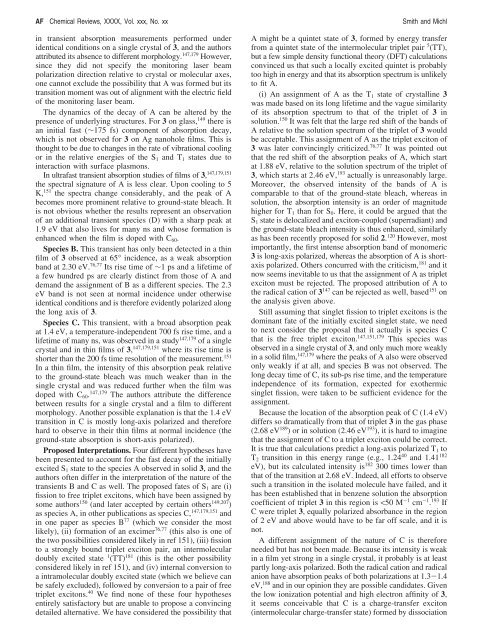
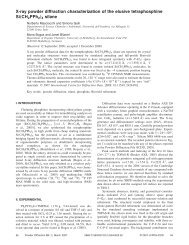

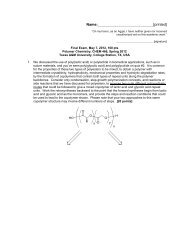

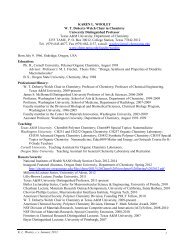
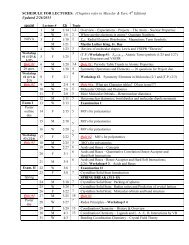
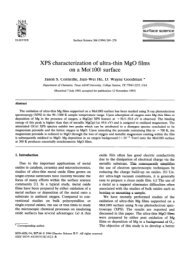
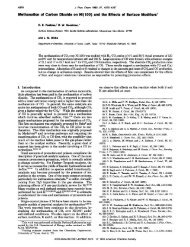
![Radical salts of TTF derivatives with the metal–metal bonded [Re2Cl8]](https://img.yumpu.com/10115211/1/190x253/radical-salts-of-ttf-derivatives-with-the-metal-metal-bonded-re2cl8.jpg?quality=85)



